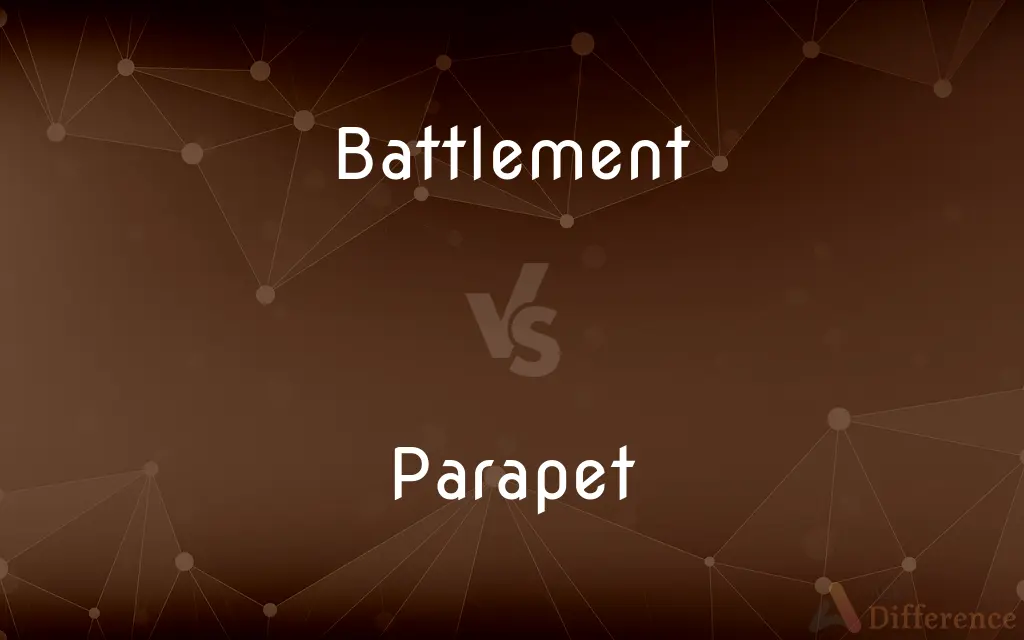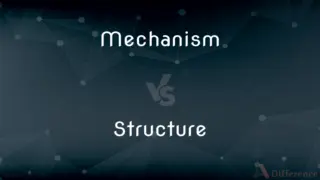Battlement vs. Parapet — What's the Difference?
By Tayyaba Rehman & Fiza Rafique — Updated on April 21, 2024
Battlements, featuring crenellations for defense, are common in medieval architecture, whereas parapets are protective walls on edges of roofs or balconies, not necessarily crenellated.

Difference Between Battlement and Parapet
Table of Contents
ADVERTISEMENT
Key Differences
Battlements are an architectural feature typical in medieval fortifications, designed with alternating raised sections (merlons) and gaps (crenels) to provide cover and firing positions for defenders. Whereas, parapets are primarily protective barriers at the edge of a roof, balcony, or bridge, intended to prevent falls and sometimes serve decorative purposes.
Both serve safety functions, but battlements are specifically for combat scenarios.The design of battlements allows defenders to shield themselves during battle, using merlons, while returning fire through crenels. On the other hand, parapets may have a uniform height and are not designed with gaps for weaponry, emphasizing continuous protection and aesthetic integration with the building’s design.
Historically, battlements are associated with castles, city walls, and other defensive structures from the medieval period. Whereas parapets have been used more broadly in various types of architecture, including both historical and modern civil constructions, reflecting a wider range of applications beyond military defense.
Functionally, battlements enhance a structure’s defensive capability by providing strategic advantages against attackers. In contrast, parapets primarily enhance safety, preventing accidental falls and sometimes serving as a mount for guardrails or balustrades.
In contemporary architecture, the influence of battlements is mostly symbolic, often used stylistically in neo-Gothic or revival architecture. Parapets, however, remain practical elements in building design, fulfilling modern safety codes and architectural aesthetics without necessarily implying historical or combat-related functions.
ADVERTISEMENT
Comparison Chart
Purpose
Defensive, used in combat
Safety and decoration
Design
Alternating merlons and crenels
Uniform or varied height, solid
Historical Use
Medieval fortifications
Widespread in various eras
Contemporary Use
Mostly decorative
Functional and decorative
Symbolism
Represents medieval warfare
No specific symbolism
Compare with Definitions
Battlement
A defensive architectural element consisting of alternating raised sections and gaps on top of a wall.
The castle’s battlements were strategically designed for archers to defend without exposing themselves.
Parapet
A low protective wall along the edge of a roof, bridge, or balcony.
The roof garden was enclosed by a stone parapet for safety.
Battlement
Historical fortification feature used primarily during the medieval era.
Battlements are a distinct feature of medieval castles noted in historical texts.
Parapet
Common in various architectural styles across different periods.
Victorian homes often featured ornately decorated parapets.
Battlement
Element in Gothic and revival architecture styles.
The university building featured faux battlements to mimic a medieval aesthetic.
Parapet
Functions as a barrier to prevent falls and accidents.
Safety regulations require the installation of parapets on all high-rise balconies.
Battlement
Architectural terms often used in descriptions of ancient military fortifications.
Tour guides often explain the purpose of battlements in historical fortress tours.
Parapet
Architectural element used for both safety and aesthetic purposes.
Modern buildings often feature glass parapets that provide safety while offering unobstructed views.
Battlement
Used metaphorically to describe defensive or protective strategies.
The debate team prepared their arguments as battlements against criticism.
Parapet
Can be made from various materials like stone, brick, metal, or glass.
The designer chose a metal parapet for the industrial look of the building.
Battlement
A battlement in defensive architecture, such as that of city walls or castles, comprises a parapet (i.e., a defensive low wall between chest-height and head-height), in which gaps or indentations, which are often rectangular, occur at intervals to allow for the launch of arrows or other projectiles from within the defences. These gaps are termed "crenels" (also known as carnels, or embrasures), and a wall or building with them is called crenellated; alternative (older) terms are castellated and embattled.
Parapet
A low protective wall or railing along the edge of a raised structure such as a roof or balcony.
Battlement
A notched parapet built on top of a wall, with alternating merlons and crenels for decoration or defense.Also called embattlement.
Parapet
An earthen or stone embankment protecting soldiers from enemy fire.
Battlement
In fortification: an indented parapet, formed by a series of rising members called cops or merlons, separated by openings called crenelles or embrasures, the soldier sheltering himself behind the merlon while he fires through the embrasure or through a loophole in the battlement.
Parapet
A low protective wall.
Battlement
Any high wall for defense.
Parapet
Part of a perimeter that extends above the roof.
Battlement
(poetic) The towering roof of heaven.
Parapet
(military) A fortification consisting of a wall.
Battlement
One of the solid upright parts of a parapet in ancient fortifications.
Parapet
A low wall, especially one serving to protect the edge of a platform, roof, bridge, or the like.
Battlement
A rampart built around the top of a castle with regular gaps for firing arrows or guns
Parapet
A low wall along the edge of a roof or balcony
Parapet
Fortification consisting of a low wall
Common Curiosities
Are there specific regulations regarding the construction of parapets?
Yes, construction of parapets must comply with building codes and safety standards, which dictate their height, strength, and durability to ensure they effectively prevent falls.
Can battlements be functional in contemporary military applications?
Today, battlements are largely symbolic and aesthetic rather than functional for modern military applications, as modern warfare technology has advanced beyond the use of such structures.
What architectural styles commonly feature battlements?
Battlements are commonly featured in Gothic, Romanesque, and Medieval revival architectural styles, where they add historical character and aesthetic appeal.
How are battlements different from ramparts?
While battlements are specific features on top of a wall with alternating merlons and crenels, ramparts refer to the broader defensive walls or embankments surrounding a fort or castle.
How did battlements evolve historically?
Battlements evolved during the Middle Ages, primarily as a military feature in castle and fortification design, adapting to changes in defensive strategies and weapons technology.
What materials are commonly used to construct parapets?
Parapets are constructed from a variety of materials including stone, brick, concrete, metal, and glass, depending on the architectural style and functional requirements.
How are parapets integrated into bridge design?
In bridge design, parapets are integral for safety, preventing vehicles and pedestrians from falling off, and are often designed to complement the aesthetic of the bridge.
Do parapets affect the structural integrity of buildings?
Properly designed parapets can actually enhance the structural integrity of buildings by acting as a wind barrier and providing additional lateral stability to the roof.
How do safety requirements influence the design of parapets?
Safety requirements significantly influence parapet design, mandating minimum heights and durability to prevent accidents, especially in high-rise buildings.
What is the purpose of the gaps in a battlement, known as crenels?
The gaps or crenels in battlements allow defenders to fire weapons or observe attackers while remaining protected by the raised sections, known as merlons.
How do parapets contribute to the energy efficiency of buildings?
Parapets can help reduce wind load and can provide a mounting space for solar panels or green roofing systems, contributing to a building's energy efficiency.
What cultural significance do battlements hold?
Battlements have cultural significance as symbols of medieval warfare and defense, often romanticized in literature, film, and art.
What are some modern interpretations of battlements in architecture?
Modern interpretations of battlements might include stylistic parapets that mimic the appearance of traditional battlements, often used in theme parks or revival architecture.
What are the limitations of using parapets in construction?
Limitations of using parapets include potential restrictions on view, requirements for regular maintenance, especially in harsh weather conditions, and the need for robust construction to handle safety loads.
Can battlements be seen in residential architecture?
Battlements can occasionally be seen in residential architecture, particularly in houses designed with a historical or whimsical theme, serving more as decorative elements.
Share Your Discovery

Previous Comparison
Musk vs. Must
Next Comparison
Mechanism vs. StructureAuthor Spotlight
Written by
Tayyaba RehmanTayyaba Rehman is a distinguished writer, currently serving as a primary contributor to askdifference.com. As a researcher in semantics and etymology, Tayyaba's passion for the complexity of languages and their distinctions has found a perfect home on the platform. Tayyaba delves into the intricacies of language, distinguishing between commonly confused words and phrases, thereby providing clarity for readers worldwide.
Co-written by
Fiza RafiqueFiza Rafique is a skilled content writer at AskDifference.com, where she meticulously refines and enhances written pieces. Drawing from her vast editorial expertise, Fiza ensures clarity, accuracy, and precision in every article. Passionate about language, she continually seeks to elevate the quality of content for readers worldwide.














































